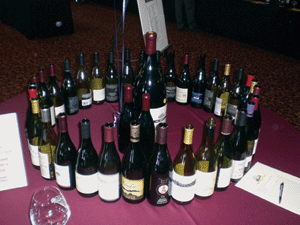
“This grape of all grapes wants to become wine.“ That is how Jeffrey Patterson, the winemaker at Mount Eden Vineyards, opened up his talk at the Santa Cruz Mountains annual Pinot Paradise. Over the years, he has come to live by the adage, allowing nature to take its course in his winemaking practices. Throughout the appellation the temperature, the rainfall, and the terroir are all so favorable to Pinot Noir there is no need to make any major alterations. Thus, Jeffery remarks, mostly as a joke, that he simply hopes and prays that the wine turns out well. Judging by the quality of his 2006 Estate Pinot, his prayers have been answered.
The six sub-regions of the Santa Cruz Mountains are all part of the “sweet spot,” but each area’s terroir results in its own particular accent on the Pinots. In fact, moving throughout appellation, it is possible to taste the changing conditions as different expressions in the Pinots.Sal Godinez, the winemaker at Vine Hill, crafts a very good Pinot Noir too, but, unlike Jeffery, he is not one for simply hoping. During his time as a winemaker, he has gathered annual data on Ph, Brix, temperature, and a number of other variables that all play into how the Pinot Noir turns out. His endeavor relied heavily on modern science. Of course, in nonscientific terms, it told him that the Santa Cruz Mountains were a “sweet spot,” providing a superb balance of variables for the fruit.
At the north end of the appellation the Skyline region provides dramatic temperature variations, with an almost daily evening fog during the summer months that brings chilly coastal air to cool off the fruit from the afternoon heat. Pinots from this region are noted for their exceptional acidity and brightness.
To the south sits the Saratoga region. Here temperatures are generally moderate, with low daytime highs and few heat spikes. Thus, growing days are long and even with sun exposure primarily from the east or south, which promotes unhurried, measured ripening. This area’s Pinot Noirs are noted for their dense berry flavors and earthy components.
Off to the east lies the appellation’s only sub-region, Ben Lomond Mountain. Vineyards are planted at 1300-1800 foot elevations and consist mainly of sand and sandy loam. Fog is a daily occurrence in the mornings all summer long, and average annual rainfall is over 30 inches. The Pinots produced here are marked by complex flavor and a powerful mineral energy.
A short journey to the northeast is the Summit Road region. The region’s highest Pinot vineyards are found here at up to a 2600 foot elevation. At such a height, these vineyards receive sun throughout the day. Canopy management practices to shade and protect the fruit in the sunshine are an integral part of growing in the vicinity. The Pinots fashioned here can be bold but balanced, with excellent tannin structures for aging.
To the southeast of the foothills is the Corralitos region. These vineyards are typically at lower elevations of only about 400 to 800 feet along the coast. Dramatic temperature shifts are common during the growing season, resulting in slow ripening to produce intense, concentrated, complex, and nuanced flavors.Just below the Summit region sits the Coastal Foothills. Growing season temperatures here range from a daily high of 80 degrees to a low of 55 degrees. The top soils are well-drained and range from one inch to three feet of sand, sandy loam, loam, and clay loam on top of weathered or lithic bedrock. From this area, the Pinot Noirs are generally fruit forward, with solid tannins, balanced acidity, and fresh minerality.











